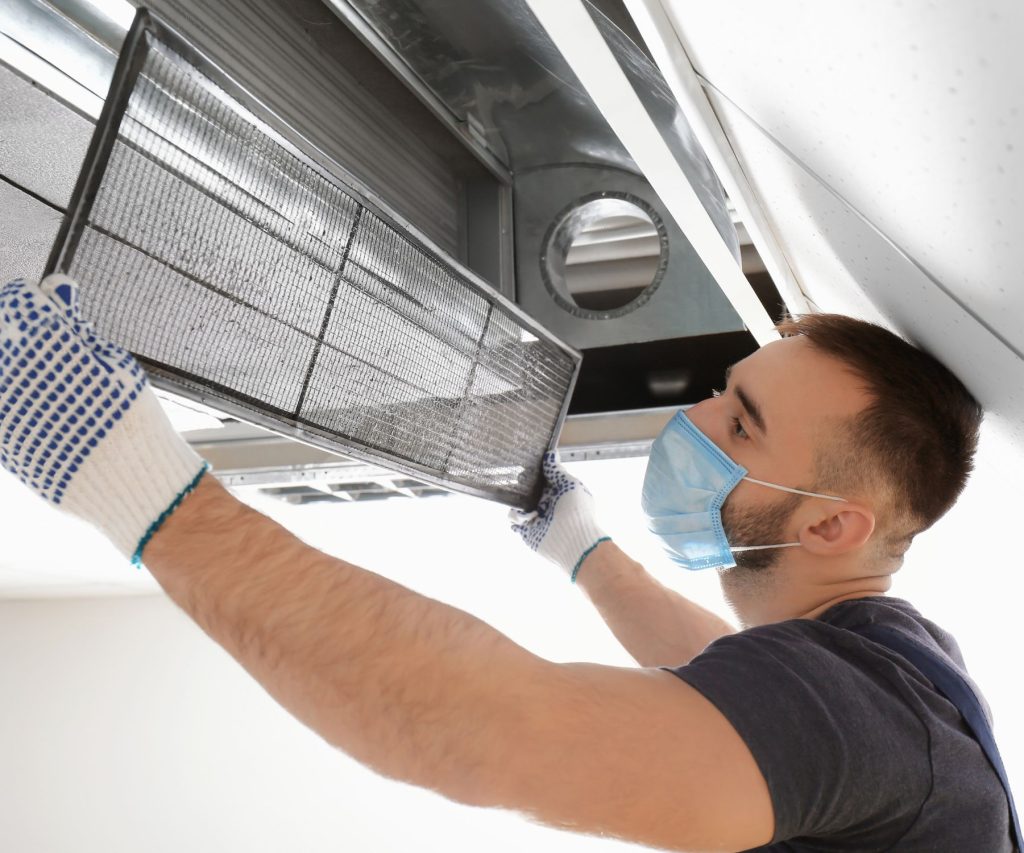Table of Contents
Mold in Central AC Units: Causes, Health Risks, and Solutions
Central air conditioning systems provide welcome relief from summer heat. But if moisture builds up inside the system, mold can begin to grow. Mold spores circulating through AC ductwork raise health concerns. Let’s examine what causes mold in AC units, the health risks, and how to remove mold for cleaner indoor air.
What Causes Mold to Grow in Central AC Units?
Several factors can cause mold growth inside central AC equipment:
Moisture – Excess humidity from leaks, condensation, or flooded components encourages mold. Older AC systems and ductwork prone to leaks are most vulnerable.
Dust buildup – Dust trapped inside the HVAC system provides food for mold spores. Lack of maintenance and changing filters allows dust to accumulate.
Poor airflow – Reduced airflow slows evaporation, allowing moisture to puddle and mold to thrive. Clogged filters or vents hinder proper airflow.
Temperature fluctuations – Frequent on/off cycling prevents the AC from dehumidifying consistently. This fluctuation in temperature and humidity fosters mold growth.
Contaminated insulation – Insulation inside the air handler or ductwork can harbor mold once it becomes wet. Porous insulation soaks up moisture readily.
With central AC systems, any excess moisture can quickly lead to out-of-control mold colonies. Proper maintenance and moisture control keep mold from gaining a foothold.
Health Dangers of Mold Exposure from AC Units
Mold spores circulating through HVAC systems get distributed throughout the home. Exposure to these spores can trigger allergic reactions and other health issues:
- Allergic reactions – Symptoms like sneezing, runny nose, red eyes, and skin rash. Mold allergies are common.
- Asthma attacks – Mold spores irritate lungs and can induce asthma episodes in sensitive individuals. Wheezing, chest tightness, coughing, and shortness of breath.
- Respiratory infections – Mold spores compromise immune function and increase vulnerability to respiratory infections like pneumonia.
- Headaches and fatigue – Toxic molds release mycotoxins that cause headaches, impaired concentration, and chronic fatigue.
- Neurological effects – Memory issues, mood changes, and tremors are associated with mold toxin exposure. Children are especially vulnerable.
Chronic mold exposure takes a real toll on respiratory health and everyday wellbeing. Remediating mold provides cleaner, healthier indoor air.
Detecting and Eliminating Mold in AC Systems
If you suspect mold contamination in your central AC equipment, take these steps:
Inspect Visible Components
- Remove and inspect air filters, looking for mold growth or dark staining.
- Check insulation inside the air handler cabinet for moisture or mold.
- Examine ductwork joints and openings for any accumulated dust or debris.
- Look for water leaks, rust, or condensation around HVAC components.
 Professional Duct Cleaning
Professional Duct Cleaning
- Hire an HVAC professional to clean ducts and remove accumulated mold spores.
- Use a high-powered vacuum with a HEPA filter to capture mold and debris.
- Clean supply and return ducts, registers, diffusers, heat exchangers, and fans.
Apply Antimicrobial Coating
- Apply an EPA-registered antimicrobial coating inside ducts and AC components.
- These coatings inhibit future mold growth and airborne spore levels.
- Routinely retreat ducts and equipment to maintain protective coating.
Address Underlying Issues
- Repair water leaks, seal ducts, and insulate condensation-prone areas.
- Increase airflow and ensure consistent temperature/humidity levels.
- Replace contaminated insulation, filters, and parts that cannot be properly cleaned.
With proactive maintenance and moisture control, you can keep central AC systems free of mold and other contaminants.
Frequently Asked Questions about Mold in AC Units
Here are answers to common questions about dealing with mold in central air conditioning systems:
How often should I change my AC filter?
Change filters every 1-3 months, more often if you have pets or allergy/asthma issues. Clogged filters restrict airflow and allow mold to flourish.
What causes condensation in AC ducts?
Temperature differences between cool supply air and warm duct surfaces cause moisture to condense. Insufficient insulation allows duct sweat and moisture.
Can I clean AC ducts myself?
You can vacuum registers and diffusers, but should hire pros to deep clean ducts. Special tools and training are needed to access and clean the full system.
What health problems are linked to mold?
Allergic reactions, asthma attacks, respiratory infections, chronic headaches/fatigue, and neurological symptoms have been associated with indoor mold.
Should I test my home for mold?
Consider a professional mold inspection if you see visible mold growth or are experiencing unexplained health issues. An inspector can identify contaminated areas.
How do I find and fix leaks in my AC ducts?
An HVAC technician can pressure test the duct system to find leaks. Sealing tape, mastic sealant, metal tape, and mesh can repair leaky duct joints.
Is mold in AC units covered by homeowners insurance?
Most policies exclude mold coverage. However, some companies offer mold coverage as an add-on. Check your policy or consult your insurance agent.
Should duct cleaning be part of yearly AC maintenance?
If you have allergy/asthma issues or odor/debris concerns, consider having ducts cleaned annually. Routine maintenance also helps prevent mold.
How long does it take to remediate mold in an AC system?
Simple surface cleaning may take a few hours. More extensive mold issues could require one week or longer to fully remediate affected areas.
Summary
Mold growth in central AC equipment should not be ignored. Left unchecked, spores distributed through supply ducts can create an unhealthy indoor environment. With routine maintenance, moisture control, professional duct cleaning, and antimicrobial treatment, you can protect your home’s air quality and your family’s respiratory health. Addressing underlying causes like leaks, airflow issues, and insulation prevents HVAC mold from recurring. Reach out to licensed HVAC contractors if you suspect your central air system has a mold problem. With proactive action, you can breathe easier knowing the air flowing from your AC vents is clean.
resources

